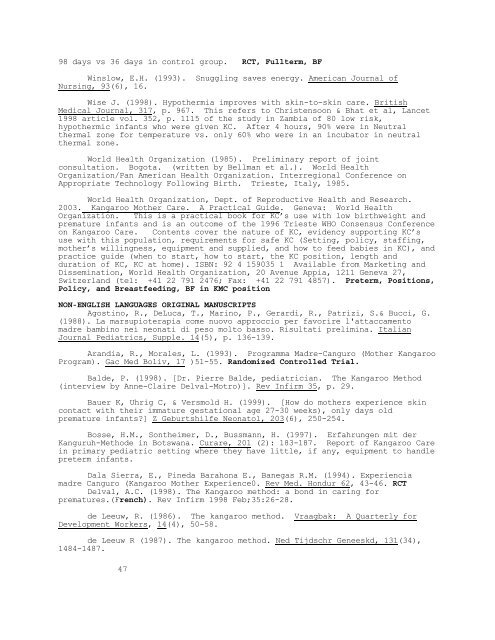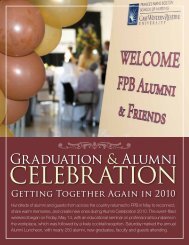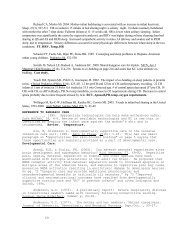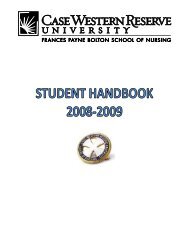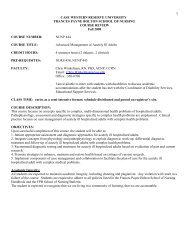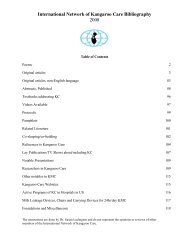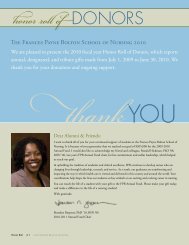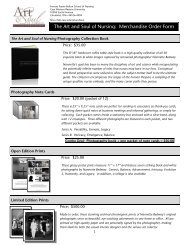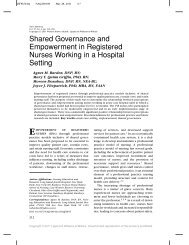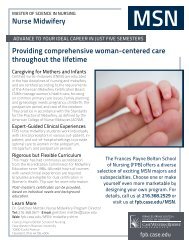Kangaroo Care BIBLIOGRAPHY Develope
Kangaroo Care BIBLIOGRAPHY Develope
Kangaroo Care BIBLIOGRAPHY Develope
You also want an ePaper? Increase the reach of your titles
YUMPU automatically turns print PDFs into web optimized ePapers that Google loves.
98 days vs 36 days in control group. RCT, Fullterm, BF<br />
Winslow, E.H. (1993). Snuggling saves energy. American Journal of<br />
Nursing, 93(6), 16.<br />
Wise J. (1998). Hypothermia improves with skin-to-skin care. British<br />
Medical Journal, 317, p. 967. This refers to Christensoon & Bhat et al, Lancet<br />
1998 article vol. 352, p. 1115 of the study in Zambia of 80 low risk,<br />
hypothermic infants who were given KC. After 4 hours, 90% were in Neutral<br />
thermal zone for temperature vs. only 60% who were in an incubator in neutral<br />
thermal zone.<br />
World Health Organization (1985). Preliminary report of joint<br />
consultation. Bogota. (written by Bellman et al.). World Health<br />
Organization/Pan American Health Organization. Interregional Conference on<br />
Appropriate<br />
Technology Following Birth. Trieste, Italy, 1985.<br />
World Health Organization, Dept. of Reproductive Health and Research.<br />
2003. <strong>Kangaroo</strong> Mother <strong>Care</strong>. A Practical Guide. Geneva: World Health<br />
Organization. This is a practical book for KC’s use with low birthweight and<br />
premature infants and is an outcome of the 1996 Trieste WHO Consensus Conference<br />
on <strong>Kangaroo</strong> <strong>Care</strong>. Contents cover the nature of KC, evidency supporting KC’s<br />
use with this population, requirements for safe KC (Setting, policy, staffing,<br />
mother’s willingness, equipment and supplied, and how to feed babies in KC), and<br />
practice guide (when to start, how to start, the KC position, length and<br />
duration of KC, KC at home). ISBN: 92 4 159035 1 Available from Marketing and<br />
Dissemination, World Health Organization, 20 Avenue Appia, 1211 Geneva 27,<br />
Switzerland (tel: +41 22 791 2476; Fax: +41 22 791 4857). Preterm, Positions,<br />
Policy, and Breastfeeding, BF in KMC position<br />
NON-ENGLISH LANGUAGES ORIGINAL MANUSCRIPTS<br />
Agostino, R., DeLuca, T., Marino, P., Gerardi, R., Patrizi, S.& Bucci, G.<br />
(1988). La marsupioterapia come nuovo approccio per favorire l'attaccamento<br />
madre bambino nei neonati di peso molto basso. Risultati prelimina. Italian<br />
Journal Pediatrics, Supple. 14(5), p. 136-139.<br />
Arandia, R., Morales, L. (1993). Programma Madre-Canguro (Mother <strong>Kangaroo</strong><br />
Program). Gac Med Boliv, 17 )51-55. Randomized Controlled Trial.<br />
Balde, P. (1998). [Dr. Pierre Balde, pediatrician. The <strong>Kangaroo</strong> Method<br />
(interview by Anne-Claire Delval-Motro)]. Rev Infirm 35, p. 29.<br />
Bauer K, Uhrig C, & Versmold H. (1999). [How do mothers experience skin<br />
contact with their immature gestational age 27-30 weeks), only days old<br />
premature infants?] Z Geburtshilfe Neonatol, 203(6), 250-254.<br />
Bosse, H.M., Sontheimer, D., Bussmann, H. (1997). Erfahrungen mit der<br />
Kanguruh-Methode in Botswana. Curare, 201 (2): 183-187. Report of <strong>Kangaroo</strong> <strong>Care</strong><br />
in primary pediatric setting where they have little, if any, equipment to handle<br />
preterm infants.<br />
Dala Sierra, E., Pineda Barahona E., Banegas R.M. (1994). Experiencia<br />
madre Canguro (<strong>Kangaroo</strong> Mother Experience0. Rev Med. Hondur 62, 43-46. RCT<br />
Delval, A.C. (1998). The <strong>Kangaroo</strong> method: a bond in caring for<br />
prematures.(French). Rev Infirm 1998 Feb;35:26-28.<br />
de Leeuw, R. (1986). The kangaroo method. Vraagbak: A Quarterly for<br />
Development Workers, 14(4), 50-58.<br />
de Leeuw R (1987). The kangaroo method. Ned Tijdschr Geneeskd, 131(34),<br />
1484-1487.<br />
47
De Luca, T, Agostino R, Muggia A, Butturini F. 1995. Il metodo marsupio.<br />
Neonatologica 9(2), 121-125.<br />
Dittrich, E. & Bartuschka, R. (1994). Gentle care in intensive medicine.<br />
Kinderkrankenschwester,13(8): 264-266.<br />
Ennen-Hansing-Eilers, M. (1997). Besonderheiten in der pflege<br />
schwerkranker fruhgeborener. KinderKrankenschwester, 16 (5): 175-179.<br />
Ezinga, G., & Ezinga-Scotten, D.E. (1985). Onderzoek naar het eventueel<br />
ontstaan van hypothermi en hyppoglykemie bij thuisgeborenen na langdurig<br />
huidcontact postpartum. Ned Tijdschr Geneeskol, 129, 449-451. FULLTERM<br />
Fischer, C.B., Sontheimer, D., Bauer, J., & Linderkamp, O. (1997). Die<br />
Kanguruhpflege Fruhgeborener. Stand der Forschung und Erfahrungen in<br />
Heidelberg. Padiatrische Praxis, 52(4), 609-619. (<strong>Kangaroo</strong> care of premature<br />
infants. Status of research and experience in Heidelberg. Has English abstract<br />
on page 617).<br />
Flament, P. (1994). Le Portage Kangourou. FINB-INFO, #6, December, 3-5.<br />
Gloppestad, K. (1998). Laktasjon hos modre til premature born: Forekomst<br />
ved forskjullige tidspunkter (Lactation in mothers of preterm infant:<br />
Prevalence at different point of times). Vard 1 Norden, 18(4), 27-35.<br />
Gomez Papi, A., Baiges Nogues, M.T., Batiste Fernadez, M.T., Marca<br />
Gutierrex, M.M., Nieto Jurado, A., Closa Monasterolo, R. (1998). Metodo canguro<br />
en sala de partos en recien nacidos a termino (Spanish). An Esp Pediatr 1998<br />
Jun;48(6):631-633. English is: <strong>Kangaroo</strong> method in delivery room for fullterm<br />
babies.. 533 normal fullterms were given KC as soon as dried and for next two<br />
hours. Temperature of infant was related to duration of KC and 96% had axillary<br />
temp >36, 98.5% of infants stayed awake with KC, and KC infants who breastfed<br />
during KC stayed longer in KC. If infant had more than 50 min. of KC he had 8<br />
times more probability of breastfeeding spontaneously. Moms tolerated it well<br />
though they were tired. FULLTERM, DELIVERY ROOM. Descriptive study, Axillary<br />
temp, Awake state, BF, Mother’s toleration of KC.<br />
Hamm, S., Stoffel, L., Strebel, E., & Wyss, E. (1993). Method for<br />
strengthening the mother-child relationship. As warm as in the kangaroo pouch.<br />
Krankenpflege-Soins Infirmiers, 86(8), 9-11.<br />
Hargboel, A. (1987). Luna- A child who has tried the <strong>Kangaroo</strong> Method.<br />
Foraldre og Fodsel, #1. No page numbers listed.<br />
Horiuchi, T. 1999. <strong>Kangaroo</strong> <strong>Care</strong> (Japanese Book). Available from Takeshi<br />
Horiuchi, M.D., Chairman, St. Marianna University School of Medicine, Yokohama<br />
City Seibu Hospital, Perinatal Center, 1197, Yasahi-ku Asahi-ku, Yokohama City,<br />
241-0811 JAPAN. (045) 366-111. e-mail: isokichi@wf5.so-net.ne.jp<br />
Hsieh Y, Huang M. (2000). Preliminary study of kangaroo care for preterm<br />
infants: Effect on parent-infant relationship. J.Nursing (China), 47(3), 33-<br />
40. See Hsieh and Huang under abstracts for this report of 16 parents who<br />
experienced KC and answered 8 open ended questions about their experience.<br />
Results were KC decreased parent’s anxiety, increased parental self-confidence<br />
in caring for infant, promoted parent-infant relationship.Preterm, Qualitative<br />
Study,<br />
Maternal/Paternal anxiety, confidence in caring for infant, relationship.<br />
Jurado A, Closa Monasterolo R. (1998). [<strong>Kangaroo</strong> method in delivery room<br />
for full-term babies.] Annals Esp. Pediatric, 48(6), 631-633.FULLTERM<br />
48
Laine, A.M. (1987). <strong>Kangaroo</strong> care in Turku's University Hospital<br />
Pediatric Clinic. Katilolehti,92(5): 171-176.<br />
Lepire E. 2000. <strong>Kangaroo</strong> mothers in Mexico. Infirm Que. 8 (2), Nov-Dec.,<br />
42-47.<br />
Legault, M., & Goulet, C. (1994). Sortir le premature de l’incubateur de<br />
la methode traditionnelle at la methode kangourou. L’Infirmiere du Quebec,<br />
2(2): 34-41.<br />
Lindroth M (1990). [the kangaroo method is a good complement to<br />
traditional incubator care]. Lakartidningen, 87(6), 368.<br />
Marino, P., De Luca, T., Butturini F, Di Meo MGV, Gizzi C, Patrizi S,<br />
Ciminera A, Muggia A, Agostino R. (1989 ed.)_ Il metodo marsupio nella cura dei<br />
neonati di peso molto basso. In Bucci G, 12 th Corso di Aggiornamento in<br />
neonatologia, Roma, 1989. Italian.<br />
Martinez JC. 199l. El contacto madre-hijo prematuro piel a piel un apote<br />
a la moderna asistencia neonatal. Arch Argent Paediatr, 89: 142-147.<br />
Mazurek T., Mikiel-Kostyra K, Mazur J, Wieczorek P, Radwanska B, Pachuta-<br />
Wegier L. 1999. Influence of immediate newborn care on infant adaptation to the<br />
environment. Med Wieku Rozwoj, 3(2), 215-224. Three randomized groups n=22in<br />
each group) (KC, swaddled newborns beside the mother, swaddled and separated<br />
from the mother) of FULLTERM newborns observed for 75 min after birth. Skin Tem,<br />
bl.glucose, HR, RR, crying differences all favored KC group. PH not sig. Diff<br />
between groups. For all but two unseparated newborns (KC or lying besides) temp<br />
was increasing during the 75 minutes, in separated group temp was unstable and<br />
not growing in 6 (27%) of infants. Bl glucose highest in KC (60.1mg/dl),lower in<br />
swaddled lying beside (52.5) and lowest in separated (49.6). Crying was shortest<br />
in KC, and 3 times longer in separated group. Episodes of crying were 7,17,and<br />
38 in KC, lying beside, separated groups respectively. KC is optimal for newborn<br />
adaptation and a protection agst hypothermia and hypoglycemia. RCT, FULLTERM<br />
Mikiel-Kostyra K, Boltruszko I, Mazur I, Zielenska M. 2001. Skin –to-skin<br />
contact after birth as a factor determining breastfeeding duration. Med Wieku<br />
Rozwoj, 5(2), 179-189.<br />
Mikiel-Kostyra, K., Mazur J. 1998. Determination of newborn feeding in<br />
maternity hospital care. Part I: Factors associated with breastfeeding<br />
initiation. Ginekologia Polska, 69(11), 783-788. Data from 11,750 FULLTERM<br />
collected from 427 polish hospitals in 1995 showed that lack of KC after birth<br />
(odds ratio 8.5; population attributable risk in percent = 60.9%) and maternalinfant<br />
separation longer than 1 hour/24 hrs (odds ratio 13%, PAR = 87.2%) are<br />
factors associated with artificial feeding.<br />
Mikiel-Kostyra K, Mazur J. 2000. Birth weight as a factor influencing<br />
infant feeding in Polish maternity wards. Med Wieku Rozwoj, 4(3), 337-346.<br />
(POLISH) FULLTERM. 11,784 newborns from 427 maternity hosps were studied. 97.2%<br />
of all newborns breastfeed; 72.5% of preterms breastfeed. KC was compared to<br />
rooming-in and was strong predictor of initiating BF and KC and rooming in as<br />
influences for BF were more evident in lower birthweight infants than higher.<br />
Moeller-Jensen H, Hjort-Gregersen K, Matthiessen M, Vestergaard HF, Jepsen<br />
BH. (1987). [Children’s health. 16. <strong>Kangaroo</strong> method used in practice at<br />
Sonderborg Hospital]. Sygeplejeersken, 87(19), 16-18.Implementation<br />
Mosseri, R., Dollberg, S. (1996). The “kangaroo mother” method<br />
(editorial). (Hebrew). Harefuah. 130(2):95-7. 1996 Jan 15.<br />
49
Mulet, R.C., Figueroa de Leon, R., Gonzalez, J.V.B. (1992). Mother-child<br />
early contact with the mothers kangaroo program and natural breastfeeding.<br />
Rev.Latin.Perinat. 12,#3-4, 54-60. See annotation under English section.<br />
Persson B. (1990). [The kangaroo method. A medical ambivalence towards<br />
nature?] Lakartidningen, 87(13), 1034-1035 SWEDISH<br />
Pignotti MS, Rubaltelli FF. (1997). <strong>Kangaroo</strong> <strong>Care</strong>: Parents’ answers and<br />
staff problems. Riv Ital Pediatri 23, 1054-1057. In three years 95% of LBW and<br />
VLBWs (580-2000 gm, 25-38wkGA) got KC. Nurses had difficulty with organization<br />
and surface space and time for mothers; mothers firmly believe in KC and its<br />
help in forming relationship with infant and nurses.Italian with English<br />
Abstract<br />
Pignotti MS, Rapisardi G, Rubaltelli FF. <strong>Kangaroo</strong> mother care: Parents’<br />
and nurses’ opinions and problems. ITALY Need complete citation from Rapisardi<br />
on the researcher’s list or at gherapi@dada.it<br />
Riskin A & Bader D. 2003. Breast is best—human milk for premature babies.<br />
Harefuah, 142 (3), 217-222, 236, 237. Review article of how breastmilk is best<br />
for preemies. States “support of lactation in mothers of preemies mandates<br />
protection of the mother and child bonding process and early skin-to-skin<br />
contact “Kangeroo care” (pg. 217). PT, Review, BF<br />
Sarman, G. 2000. Effects of KC on Mother’s Competency for Caring for<br />
Multiplets. Available from Gulnihal Sarman, M.D., FAAP, American Hospital,<br />
Guzelbahce sok. No 20, Nisantasi 80200, Istanbul, TURKEY.<br />
Shiau SH. (1999). The effects of kangaroo care on sleep and crying of<br />
healthy fullterm newborns. Nursing Research (China), 7(3): 198-208. 22 Kcers<br />
and 22 standard care infants (No sig difs between groups on demographics)were<br />
compared. Kcers had significantly less total crying (7.14 min vs 10.73, p=.000)<br />
on days 1 & 2 but not 3; Kcers had more sleep (total47.64 min vs.40.36, p=.000<br />
on days 1,2,3) and less awake time (total 14.55 vs. 17.45 min, p=.046) and less<br />
awake time on day 3 but not on days 1,2. FULLTERM, RCT crying, sleep,<br />
wakefulness Chinese.<br />
Sluis M (1987). [Communication with the help of the kangaroo method].<br />
Tijdschr Ziekenverpl 41(14), 440-442.<br />
Stening, W., Lohe, M., Meiritz, N., Rutenfranz, P., & Roth, B. (1996).<br />
Kanguruh-methode bei Fruhgeborenen. Monatsschr Kinderheilkd, 144: 930-937. (Has<br />
English Abstract pg. 931)<br />
Stening, W. (1997). Die Kanguruh-Methode (Haut-zu-Haut-Kontakt) bei<br />
fruhgeborenen Kindern. Kinderkrankenschwester 1997 16(8):308-310.<br />
Stening, W, Kribs A, Kiencke P, Stutzer H, Roth B. 1999. Verbreitung der<br />
Kangeruh-Methode in Deutschland. Monatsschr Kinderheilkd, 147, 766-769. KC in<br />
routine care in German NICUs.<br />
Vaivre-Douret, L., Papiernik, E., Relier, J.P. (1996). Methode et soins<br />
kangourou. Archives de Pediatrie. 3(12):1262-9, 1996 Dec.<br />
Vial M. 1991. L’unite de surveillance des nouveau-nes a la maternite dite<br />
“Les Kangourous”. In Raimbault G, Manciaux M (Eds.) Enfance menacee. Analyses<br />
et prospectives. Paris: Editions Inserm. P. 137-141.<br />
Vial M. 1995. Organisation d’une unite “Kangourous”. In Papiernik E.,<br />
50
Cabrol D., Pons JC (eds.) Obstetrique Paris: Flammarion Medicine-Sciences. P.<br />
151-154.<br />
Vial-Courmont M. 2000. The “kangaroo” ward. Med Wieku Rozwoj, 4 (2 Supple<br />
3), 105-107. Polish report of Paris experience at Clamart academic<br />
hospitalwhere it began in1987. Article discusses organization of KC ward, list<br />
advantages of kc as continuous contact, less maternal anxiety, better well-being<br />
of child, more efficient maternal involvement. Clinical Report, Implementation.,<br />
maternal anxiety,caregiving, well-being of child<br />
Villalon UH, Alvarez CP, Baria HE et al. 1992. Effect of early skin-toskin<br />
contact on temperature regulation, heart rate, and respiratory rate in<br />
healthy, full-term newborns. Rev Chil Pediatr, 63: 140-144.FULLTERM. See review<br />
under English section.<br />
Villalon, UH, Alvarez, CP. (1993). Short term effects of early skin-toskin<br />
contact (kangaroo care) on breastfeeding in healthy fullterm newborns. Rev.<br />
Child Pediatr. 64(2), 124-128. FULLTERM. BF and maternal confidence. See review<br />
under English section.<br />
Virgin C, (1987). [Children’s Health. 15. <strong>Kangaroo</strong> method returns children<br />
to mothers]. Sygeplejersken, 87(19), 10-14.<br />
von Stockhausen, H.B. (1997). Kommentar: Auf Anforderung der<br />
Schriftleitung. Padiatrische Praxis, 52(4): 618-619. Commentary on Fischer<br />
article of 1997 reporting KC in Heidelburg.<br />
Wahlberg V (1985). [The natural incubator. Report on “kangaroo methods” in<br />
Colombia, South America]. Jordemodern, 98(10), 315-319.<br />
Wahlberg, V. (1991). The "<strong>Kangaroo</strong> method" and breastfeeding in low birth<br />
weight babies. Nu Nytt on U-landshals vard, 5, 23-27.<br />
Wahlberg, V., Persson, B., & Affonso, D. (1987). Kangurumetoden-den<br />
manskliga kuvosen. Lakartidningen,87(5), 288-289.<br />
Warren L, Tan GC, Dixon PD, Ghaus K, (2000). Breastfeeding success and<br />
earl discharge for preterm infants: The results of a dedicated BF programme. J.<br />
Neonatal Nursing 6 (2), 43-48.BF Get this from D. Dowling.<br />
Wieland, Ch., Bauer, K., Bisson, K. & Versmold, H. (1995). Kanguruh-pflege<br />
bei 39 Fruhgeborenen. Monatsschr Kinderheilkd, 143:1099-1103. 39 spontaneously<br />
breathing preterms were given first 30 minute KC session on day 10. Rectal temp<br />
increased during KC by 0.23C (p=
Yin Y, Wang R,Lee MM, Yuh Y. 2003. Mothers’ satisfaction: KC vs.<br />
traditional nursing care for premature babies (Chinese). J Nurs (China), 50 (2),<br />
37-47. English abstract available: Preterms
17. Arestegui, R.U. Information about the mother kangaroo pilot program at the<br />
San Bartolome Hospital in Lima, Peru. p. 249-254.<br />
18. Martinez, J.C. Mother kangaroo program is a great opportunity for modern<br />
neonatal help. p. 255-260.<br />
19. Picon, C. Low birth weight premature infants: An environmental technology<br />
appropriate for resistance. p. 261-278.<br />
20. de Molina, H. Evaluation of mother kangaroo program at the Dr. Luis Edmundo<br />
Vasquez Hospital in Chalatenango, El Salvador. p. 279-282.<br />
21. Diaz-Rosello, J.L.D., Lozano, P.M., & Tenzer, S.M. Impaired growth of low<br />
birth weight infants in an early discharge program. p. 283-306.<br />
22. Meza, G.C., Rosales, J.M., & Pineda, D.P. Efficacy of mother kangaroo<br />
program in the development of low birth weight infants at Roosevelt Hospital in<br />
Guatemala. p. 307-350.<br />
23. Mulet, R.C., Figueroa, de Leon, & Gonzales, J.V. Efficacy of mother<br />
kangaroo program in the development of low birth weight neonates at the Social<br />
Security Obstetric Hospital in Guatemala, p. 351-361.<br />
24. De Leeuw, R. History of kangaroo care in the neonatal department of the<br />
academic medical center. p. 365-370.<br />
25. Anderson, G.C., Overview of current knowledge about skin-to-skin (<strong>Kangaroo</strong>)<br />
care for preterm infants -p. 371-390.Lit Review.<br />
26. Anderson, G.C. Risk in mother-infant separation postbirth. p. 391-402.<br />
27. Ludington, S.M. Energy conservation during skin-to-skin contact between<br />
premature infants and their mothers. p. 403-416.<br />
28. Whitelaw, A. <strong>Kangaroo</strong> baby care: Just a nice experience or an important<br />
advance for preterm infants: p. 417-420.<br />
29. Wahlberg, V. Alternative care for premature infants - the <strong>Kangaroo</strong> method:<br />
Advantages, risks, and ethical questions. p. 421-430.<br />
30. Borel J., B., Mayorga G, V., & Vado L., C. Alternate care for neonates<br />
weighing less than 1800 grams in the Bertha Calderon Roque Women's Hospital,<br />
Managua, Nicaragua. p. 431-450.<br />
31. Davanzo, R. <strong>Care</strong> of the low birth weight infant with the <strong>Kangaroo</strong> mother<br />
method in developing countries. p. 451-474.<br />
32. Virgin, C. The kangaroo method brings the child back to its mother: Present<br />
and future in Denmark. p. 475-484.<br />
Abstracts<br />
Agbodjan-Djossou AO, Akue D., Peeira SB, Maboudou AL, Assimadi JK. 2000.<br />
The raising of premature inants by KM: Experience at Tokoin Teaching Hospital<br />
Lome-Togo. Paper presented at 3 rd International KM Congress, Jakarta, Indonesia,<br />
Nov. 22-25, 2000. Report of 66 infants, 30-33wksGA given KC. Daily mean wgt<br />
gain was 22.8gs.Mean duration of KC was 13 days. No mortality.<br />
Agostino, R, De Luca., T., Marino, P., Gerardi, R., Patrizi, S.,<br />
d’Apolito, S., & Bucci, G. (1988). La marsupioterapia come nuovo approccio per<br />
53


